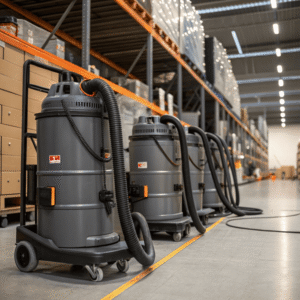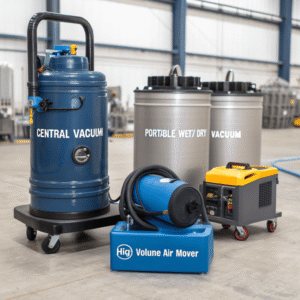Industrial Vacuum Cleaners Outperform Sweeping In Every Way?
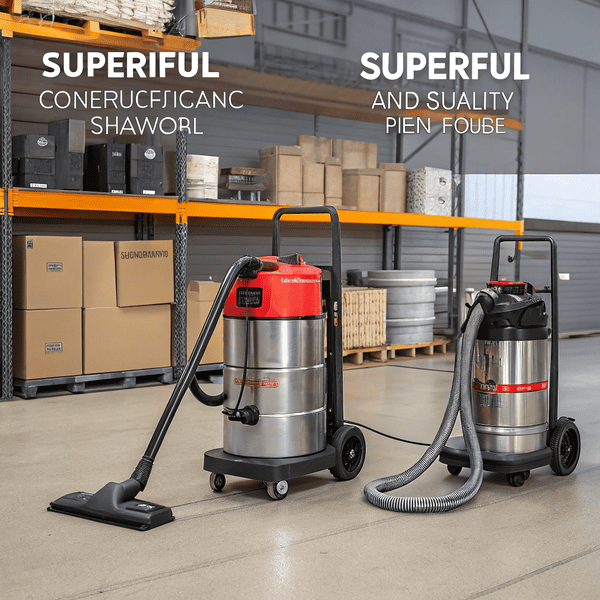
A A spotless manufacturing floor is hard to achieve. People still debate: should you sweep or invest in an industrial vacuum cleaner[^1]? Let’s break the deadlock.
[^1]: Explore this link to understand how industrial vacuum cleaners can enhance cleanliness and efficiency in manufacturing.
floor is hard to achieve. People still debate: should you sweep or invest in an industrial vacuum cleaner? Let’s break the deadlock.
Industrial vacuums remove dust, allergens, and small particles far better than sweeping, especially in demanding manufacturing sites. They boost efficiency, improve air quality, and reduce labor time, making them a smart choice where cleanliness matters.
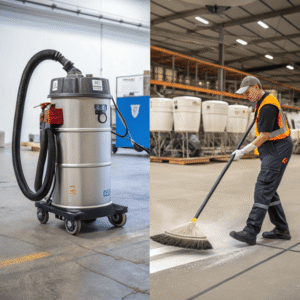
Sometimes clearing up seems easy—just grab a broom and start sweeping. But if you want real cleanliness, simply moving dirt around may not be enough. In my years on the shop floor, I’ve seen how overlooked debris leads to slips or equipment failure. That taught me to look for the best tool, not just the fastest one.
Are Industrial Vacuum Cleaners Better?
A A sparkling production line impresses customers. A broom can’t always provide that. Tired of seeing clouds of dust[^1] reappear after sweeping?
[^1]: Learn effective strategies to eliminate dust clouds and maintain a clean working environment.
impresses customers. A broom can’t always provide that. Tired of seeing clouds of dust reappear after sweeping?
Industrial vacuum cleaners are more effective than sweeping because they trap dust and fine particles, improve air quality, and make large cleaning tasks faster and more thorough.

Walk into any modern factory. You’ll see people using powerful vacuums in spots where brooms fail. This is no accident. Sweeping pushes dust and debris into the air or hard-to-reach places. Industrial vacuums catch particles at the source, including those your eye can't see. Trapping dust means contaminants don’t move to other work areas. Many units are fitted with HEPA filters, so they maintain a healthier environment for workers. I recall one project where switching to vacuums cut cleanup time in half and left the air clearer. Let’s look at the results side by side:
| Feature | Sweeping | Industrial Vacuum Cleaner |
|---|---|---|
| Removes fine dust | No | Yes |
| Air quality | Poor | Significantly improved |
| Labor time | High | Reduced |
| Safety | Lower | Higher |
If you use a broom, you can’t pick up everything. If you use a vacuum, the floor is truly clean.
Is Vacuuming More Effective Than Sweeping?
Some think the old-fashioned broom is enough. I used to believe that too. Then I learned how small particles cause big problems over time.
Vacuuming is more effective than sweeping because it removes both visible debris and invisible contaminants, preventing them from recirculating or accumulating in hidden areas.
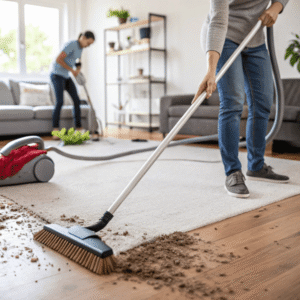

Why does effectiveness matter? In precision industries like electronics or mold making, dust is the enemy. Brooms can’t reach into cracks or pick up In precision industries[^1] like electronics or mold making, dust is the enemy. Brooms can’t reach into cracks or pick up micro-particles. Most sweepers miss metal shavings, chemical dust, and fine debris that damage machines or products
[^1]: Understanding precision industries can help you grasp their importance in technology and manufacturing.
. Most sweepers miss metal shavings, chemical dust, and fine debris that damage machines or products. Vacuums pull up contaminants instantly—before they settle into corners or float onto product surfaces. This means each pass really removes dirt, not just moves it aside. For people like me who must meet strict standards, vacuuming gives true peace of mind. The table below shows what gets left behind:
| Contaminant | Sweeping | Vacuuming |
|---|---|---|
| Large debris | Yes | Yes |
| Fine dust | Rarely | Always |
| Allergens | No | Yes |
| Hazardous particles | No | Yes (with HEPA) |
If quality or safety matters to you, don’t just sweep—vacuum.
What Is the Difference Between a Regular Vacuum and an Industrial Vacuum?
At home, using a handheld vacuum works for carpets. In a factory or workshop, cleaning demands are much tougher. Not every vacuum stands up to the challenge.
The main difference is that industrial vacuums offer stronger suction, larger capacity, better durability, and can handle hazardous or heavy debris, unlike regular household vacuums.

Let’s break this down. Let’s break this down. Regular vacuums are made for dust, pet hair, and small debris. They struggle with heavy loads[^1], liquids, or sharp metal fragments
[^1]: Exploring methods for cleaning heavy loads will provide you with better solutions for tackling tough messes.
are made for dust, pet hair, and small debris. They struggle with heavy loads, liquids, or sharp metal fragments. Industrial vacuums have powerful motors, thicker hoses, larger dustbins, and tougher builds. Most can run for hours without stalling. Some are explosion-proof, suited for picking up combustible dust. Others include advanced filters, handling everything from plastics to metal shavings. I remember burning out a cheap vacuum on a mold shop floor—it lasted six days before failing! Here’s a quick breakdown:
| Feature | Regular Vacuum | Industrial Vacuum |
|---|---|---|
| Suction power | Low to moderate | High |
| Debris type | Light dust, crumbs | Heavy, wet, hazardous |
| Filter type | Standard | HEPA, specialty filters |
| Durability | Limited use | Continuous use, rugged |
| Price | Low | Higher (but longer life) |
Choosing the right type means fewer breakdowns, safer work, and a cleaner result every time.
Conclusion
Industrial vacuums clean better, save time, and make workplaces healthier compared to sweeping or household vacuums.

